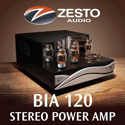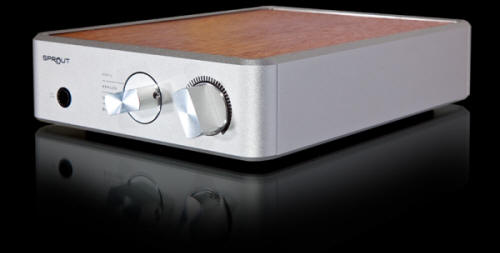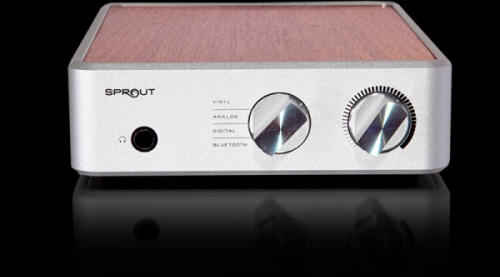|
|
You are reading the older HTML site
Positive Feedback ISSUE 79
ps audio Sprout - A "Complete" Amplifier as reviewed by Steve Lefkowicz
Over the past several years, one of the big topics in field of high end or perfectionist audio has been how to get new people, and especially younger people, to participate. That means not just getting a new generation to both appreciate better sound and gear, but more importantly, getting them to actually buy better stereo gear, too. Not necessarily replace their iPod and headphones, but add to it a real system whether desktop or full room, to help them enjoy their ever present musical desires. For the most part, the industry as a whole, and the aging population that make up the bulk of audiophiles, has a really bad job with this. Between telling twenty and thirty-somethings that their music sucks, to focusing on products that are too expensive, and generally too inconvenient to use (at least for a "beginner") we basically have been telling them to stay away. I wrote a brief opinion piece on this very topic back in Issue 64 of PF. A few companies have been trying to figure out how to address this segment, and are looking to put products on the market that people who listen to music and might want better sound, might actually like, but without breaking the bank or devoting too much time or effort into it. Long time high-end stalwart and cost conscious innovator PS Audio and put just such a product out, and to much fanfare. I should note that I am a long time admirer of PS Audio's work, and had one of their early 1980s vintage model 4H preamps in my system from 1984 until late last year. I first heard of PS Audio in the mid 1970s when a friend in college bought one of their very first outboard phono stages. That was a revelation in sound in a system that used a Denon 103 in a Rabco Arm on a Harman Kardan table, through modified Dynaco tube electronics and big Speakerlab speakers. It was part of what got me on this path in the first place. The PS Audio Sprout is clearly directed at this market segment, by design, function, feature set and marketing plan. Even its crowd-funded origins speak to a more open, youthful audience. To look at the Sprout, it almost seems the antithesis of the traditional audiophile aesthetic. It is small at just 6 inches wide by 8 inches long by 1.75 inches high; about the size of a hard cover book, a comparison I find somewhat ironic considering you don't think of today's youth as reading a lot of hard cover books. It also looks, on the surface, to be very simple, with just volume and selector knobs, along with a headphone jack, on the front.
A look at the back however, tips you off that this is no simple, one trick pony of an integrated amp. In addition to the expected 5-way speaker posts, EIC power connector, and power switch, the back includes inputs for digital (both USB and RCA), analog input and output (using stereo mini plugs) and a pair of RCA plugs for Vinyl (couldn't they have been less hipster and just used phono?) to handle moving magnet or high output moving coil cartridges. The only missing input I would have liked would have been a Toslink optical input, just because that would have allowed me to easily hook my ATT Uverse receiver to it for movies. Construction, fit and finish, and overall styling are very nicely done. This is actually extra important in a product like this, as, unlike seasoned audiophiles that might be used to some, shall we say eccentricities in this regard sometimes; the intended audience will look at $799 as a fairly expensive luxury item. It has to look and feel the part of being something special. Looking at it from a capabilities standpoint, it is quite complete in what it offers. The 50-watt Class D amp (rated into 4 ohms, only 32 watts using the more traditional 8 ohm rating) should be enough to drive most small, desktop, or higher efficiency speakers, certainly enough for my floor standing Tekton Lores, I figured. The USB input is asynchronous and can handle up to 24/192 files (sorry, no DSD). The Vinyl input as already stated, will handle HO MC and MM cartridges, but is not adjustable for gain or capacitance. One other input, clearly directed to the younger iPhone crowd, is Bluetooth. I don't have a Bluetooth capable player or phone, but I did briefly try my wife's iPhone with some iTunes downloads just to check it out. It worked fine, but didn't really interest me.
Setup seemed easy enough; I downloaded and installed the Windows drivers to the Asus notebook I use as a music server (Win 7, JRiver Media Center 19), which I then connected with a low cost Straightwire USB Link cable. No issues there at all, at least at first. Initially, since I don't have a phono cartridge with enough output for the phono stage, I played my Linn LP12 (Hercules II / Mose powered, Ittok arm and Dynavector 19a cartridge) through an iFi iPhono into the auxiliary input (using an Audioquest Evergreen cable). Later I borrowed a Cinemag step-up transformer and played through the Sprout's built in Vinyl input. I also connected my Pure I-20 iPod dock into the RCA digital input, though that didn't work out too well, as if both the USB and RCA are used, it defaults to the USB if it sees a connection. So, I had to turn the server off to connect to the iPod. I hooked up my Tekton Lore speakers, let the system warm up, and played Internet radio all day for several days while I was at work to break thing in. One odd quirk that occurred several time the first couple of weeks, was that if the music server went to sleep or was turned off, on restarting it wouldn't find the Sprout's driver, and showed "no audio device installed." I had to reload the driver each time. Then, after a couple of weeks, it stopped happening, and the driver ran fine from that point on. The Mac owners can now condescendingly mutter Windows… Starting off with digital from the server, listening to a variety of formats (FLAC and Apple Lossless ripped from CD, 24-bit FLAC, AIFF and WAV files downloaded at 48, 88, 96, 172 and 192KHz, and DSD files (converted to 24/172 on the fly in JRiver), things seemed pleasant enough, but as has happened with every new digital device I've tried, something seemed missing. As has become a necessity with every DAC I've tried, I re-connected the iFi iUSB power supply between the server and the Sprout, and after reloading the driver again (it didn't see the Sprout after restarting the system) things were much improved. See my article in Issue 66 for what the iUSB power supply brings to a system. Also, please understand that the iUSB does not effect the DAC itself, it only cleans up the noise generated by the PC source. Bits might be bits, but electrical noise is forever. How effective it is will depend on how noisy your PC is internally. I've used the iUSB with four different notebooks, and it was essential with each of them. Having said all that, and given a week's worth of daily warm up and break in, it was time to take a real listen. I actually started off using the headphone output, to drive my long-time standby 600 ohm Beyerdynamic DT770 Pro headphones. Not every headphone amp can drive these well, which is why I primarily use a Schiit Valhalla amp for them. It is an OTL tube amp designed specifically for high impedance loads, and sounds absolutely wonderful with the Beyers. And, that is regardless of whether you consider its $349 price as expensive or low cost (though it is quite the bargain). As a headphone amp/DAC unit, the Sprout certainly sounded different than the Valhalla/iDAC combo I use, as would be expected. The full, luscious sound of the Valhalla was replaced with a crisp, tight and somewhat lean sound, especially noticeable in the higher frequencies. Background noise was suitably absent, and certainly clarity and detail were no issue. Bass response was punchy, but lacked a little extension and tone compared to the Valhalla. Throughout the whole midrange the sound remained very listenable and non-fatiguing, though maybe lacking a little color and mood. I put in some long listening session with the headphones, and found this aspect of the Sprout very enjoyable. I would have liked to have tried some other headphones, maybe with a more suitable impedance rating, but unlike many headphone users, I only have the one set. Next step was to try this out with speakers. I get the impression the Sprout was possibly designed with the idea of using it in a desktop system, or a small room with little bookshelf speakers. Not so much because of its power rating, but because of its sound characteristics and presentation. Why do I say that? Let's explain... First up speaker-wise was my current favorite budget speaker, and the primary set in my system, the Tekton Lore. With it 98dB efficiency and 8 ohm nominal load, it is a very easy speaker to drive, and the 32 watts or so that the Sprout offered should be plenty. Plus, the Lores are extremely dynamic and have a very powerful and extended bass capability, much more so than most small budget stand mounted speakers. We're talking shake the walls in the 30 to 40Hz range bass, something I get on a regular basis with the 15 watt KT88 based Antique Sound Labs MG-SI15DT-S amplifier I usually use. Yet with the Sprout, the sound just never opened up they way I'm used to. Dynamics were somewhat constricted, and the bass, though punchy in the upper/mid bass range, lacked the depth and power I'm used to. Now, that could be that the Tektons don't necessarily mate up well to Class D amplifiers. I had similar, though less noticeable issues with the only other Class D amp I've used (the much more expensive IQ Audio M300, see Issue 72). With those amps, though everything seemed to sound okay, there was nothing about them to really make me enthusiastic about listening to them. Moving from the music server to the phono section, and using a Cinemag 3440 step up (custom made by my buddy Russ Stratton) I couldn't get rid of a nasty 60Hz hum, regardless of the ground lift switch position or any number of various ground wires added to it. This wasn't due to anything wrong with the Sprout itself, just the combination of it with the step up transformer. I did try plugging my Linn in directly to the phono input, and there was no noticeable hum, but there was also nowhere near enough gain to play with the low output Dynavector cartridge (nor would it be expected). Instead, I fed the iFi iPhono stage into the line level input, to get a taste of what the Sprout sounded like without reference to its DAC. Pretty much the same. Compared to other amplifiers I normally use, the sound was just a little blah. Fortunately, for the last few weeks of the review period, I had the use of a possibly more appropriate speaker, the smaller, less full range, but otherwise beautiful sounding Fritz Speakers LS-Fritzie ($1695, review almost competed). The LS-Fritzie is a smaller, stand mounted system using a coaxial driver that offers remarkable sound with bass extension into the mid 40s. This mated up much better with the Sprout, especially when I set up a smaller, close in arrangement where I was only about 5 feet from the speakers. Here, the lack bass power and extension seemed to be less noticeable, and overall the system was very pleasant to listen to. I then went a step further and set everything up as a desktop system, with the LS-Fritzies on a table with the Sprout and my notebook in between. I'm not sure if the LS-Fritzies are voiced for such near field listening, but this worked really well. There was a nice immediacy in the sound, everything was close up and quite exciting. As I sat listening to this, the first time I've ever really set up a "desktop" system, I understand now why some people go this route. It minimized room interaction, keeps things nice and tidy though certainly limits the size and scope of the soundstage (a shame, as the LS-Fritzie does a wonderful job generating a large, well defined soundstage given some space and breathing room). I think we do have to look seriously at the intended market. As I see it, this is not a product for hardened veteran audiophiles to look at as a replacement for their separates, tubes and tweaks. It might best be looked at as the ever sought after entry level product, that really gets someone who doesn't have much high end experience a chance at starting off on the right path. Here's an easy to set up, easy to use, all in one unit that does everything you need, looks good and doesn't take up a lot of space. I really think it is best utilized in a smaller room or in a desktop system environment, with headphones or suitable, small near field speakers. I think bass extension is expected to be handled via a powered subwoofer (there is an output for that). The only current product I've tried that is even close to the same category, though from the opposite end of the spectrum, would be the Clones Audio 25i. However, that integrated amp costs more, does not have a built in DAC, phono stage, headphone output or Bluetooth capability, and its chip based amplifier is less powerful and even more critical of the speakers you might hook up to it. I can't help but think someone considering either of these products would not seriously consider the other one. I will say the 25i did match up to my Tekton Lore speakers very nicely, though not so well with any of my other speakers. Given that context, there is a lot to like about the Sprout, and it can be certainly recommended for its intended purpose. I can already think of a few friends I will specifically be recommending it to as their first (and maybe only) venture into setting up a "real stereo" at home. It offers a modern level of ease and convenience, is very well built, and hits all the target points for what you can hook up to it. A very interesting piece directed specifically at a very important market segment. Steve Lefkowicz PS Audio Sprout Price ($799) Unit Weight 2.9 lbs Unit Dimensions 6" x 8" x 1.75" Shipping Weight 5 lbs Shipping Dimensions 22.5"x 13" x 6" [57cm x 33cm x 15cm] Input Power Model specific 120VAC, or 230VAC 50 or 60Hz Power Consumption <10W idle, 125W maximum Phono Audio Input RCA (X2) Cartridge type Moving Magnet Cartridge Output (5cm/s) 2mV to 50mV Cartridge load impedance 47KΩ(100pF) Equivalent Input Noise <1.6uV S/N ratio >80dB (@analog output, ref 4VRMS maximum output) Analog Audio Inputs: Connector 3.5mm stereo input Input level 2.0VRMS (+6dBV) Input impedance 10KΩ Analog Audio Output: Connector-3.5mm stereo connector can be used for subwoofer or amplifier feeds Output level, nominal (@ rated cartridge input) 1.0V (0dBV) with 5mV cartridge at reference level (volume at 100%) Output level, maximum 4.0VRMS (+12dBV) maximum, full scale digital or vinyl at +12dB over reference (volume at 100%) Output Impedance 220Ω S/N ratio >94dB (@analog output, ref 4VRMS maximum output) THD (power amp) <0.03% (1W 50Hz-10KHz) <0.1% at rated power, 1KHz, 120VAC mains S/PDIF Digital Input: Connector RCA (Coax) Impedance 75Ω Format PCM USB Input: Connector USB "B" Type Format PCM Transfer mode Asynchronous S/N ratio digital >102dB (@analog output, ref 4VRMS maximum output) Bluetooth: Antenna Built in DAC Uses Sprout's built in asynchronous DAC over S/PDIF Stereo Power Amplifier Output: 8Ω loudspeakers connected 32 watts per channel, both channels driven 4Ω loudspeakers connected 50 watts per channel, both channels driven Headphone Output Power: 16Ω headphones 1W (1KHz, 1% THD) 300Ω headphones connected 200mW (1KHz, <0.03% THD) Headphone Output Impedance: From 10Hz to 10kHz <0.3 Ohm |


.gif)










